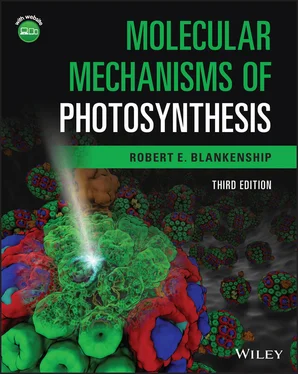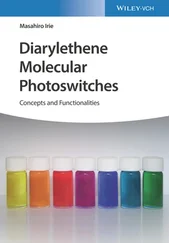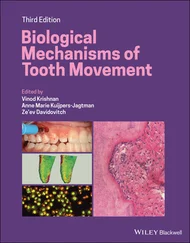Chlorophyll e was isolated and named provisionally in the 1940s, but the structure has never been determined and so its structure and function remain uncertain.
Chlorophyll f is the most recently discovered of all the chlorophyll‐like pigments. It contains a formyl group at the C‐2 position. It was found in cyanobacterial cultures isolated from microbial structures called stromatolites (Chen et al ., 2010; Chen et al ., 2012), but is now known to be present in a wide range of cyanobacteria that have been grown using far‐red light (Gan et al., 2014). Similar to the case in chlorophyll d , the formyl group at the C‐2 position shifts the absorbance maximum of this pigment substantially to longer wavelengths compared to chlorophyll a .
4.1.7 Bacteriochlorophyll a
The chemical structure of bacteriochlorophyll a is shown in Fig. 4.4. It is the principal chlorophyll‐type pigment in the majority of anoxygenic photosynthetic bacteria. The chemical differences between the structures of chlorophyll a and bacteriochlorophyll a are the acetyl group at the C‐3 position and the single bond in ring B between C‐7 and C‐8, instead of the double bond found in chlorophylls. This reduces the degree of conjugation in the macrocycle and also reduces the symmetry of the molecule compared with chlorophylls. These structural changes exert major effects on the spectral properties, which are discussed below.
A few species of the purple photosynthetic bacteria have been found that use zinc (Zn) as the central metal instead of Mg in bacteriochlorophyll a (Wakao et al ., 1996). These organisms are found in highly acidic environments where Mg 2+is readily displaced by H +, whereas Zn is more stable as a central metal. These are the only two metal ions that have been found incorporated into natural chlorophylls, although many other metals can be inserted synthetically into the metal‐free pigments. The reason for this specificity is probably that Mg is very readily available, whereas Zn is a trace element in almost all environments and would therefore often be a limiting nutrient. As discussed below, most other metals are unsuitable for photosynthesis, because pigments with these metals incorporated have a very short excited state lifetime. Zn bacteriochlorophyll has also been found in reaction centers of chloroacidobacteria (Tsukatani et al ., 2012).
4.1.8 Bacteriochlorophyll b
Bacteriochlorophyll b is found only in a few species of purple bacteria. It differs from bacteriochlorophyll a only by the presence of an exocyclic double bond at C‐8 in ring B, which is called an ethylidine substituent. Its chemical structure is shown in Fig. 4.4. Bacteriochlorophyll b has the longest‐wavelength absorbance band of any known chlorophyll‐type pigment. in vivo , its absorbance maximum is at 960–1050 nm.
4.1.9 Bacteriochlorophylls c, d, e, and f
Bacteriochlorophylls c , d , e , and f will be considered as a group, because they are found only in green photosynthetic bacteria, organisms that contain the antenna complex known as a chlorosome. They are also unusual among chlorophylls in that they are invariably found as complex mixtures of closely related compounds instead of as a single compound of unique structure. Several distinct structural features are found in these pigments, whose structures are shown in Fig. 4.4. Ring B contains a C‐7–C‐8 double bond, as in chlorophylls, making these pigments chlorins instead of bacteriochlorins. They also have a hydroxyethyl substituent at the C‐3 1position in ring A. This functional group is essential to the aggregation of these pigments in the chlorosome, which will be discussed in Chapter 5. The C‐3 1carbon is chiral, and both R and S diastereomers are found in cells (the C‐17 and C‐18 chiral carbons are stereochemically pure). These pigments also have hydrogens at the C‐13 2position, instead of the bulky carboxymethyl substituent found in all other chlorophylls. This change allows the chlorin rings to pack together more closely. These pigments are structurally programmed for aggregation, and indeed, in the chlorosome, they are found as large oligomeric complexes with little protein.
The differences among the bacteriochlorophylls c , d , e , and f occur primarily in the C‐20 methine bridge position, where bacteriochlorophylls c and e have a methyl substituent, and at the C‐7 position, where bacteriochlorophylls e and f have a formyl substituent, like chlorophyll b . These changes tune the light absorption properties of these pigments, with the wavelength of maximum absorption decreasing as one goes from bacteriochlorophyll c to f . Other differences are found at the C‐8 and C‐12 positions, where a complex variety of substituents can occur, even in a single organism. The tails of these bacteriochlorophylls are also different from those of most other chlorophylls. The bacteriochlorophylls c , d , and e found in the green sulfur bacteria contain a farnesol tail instead of a phytol. This is one isoprene unit shorter than phytol. The filamentous anoxygenic phototrophic bacteria, which contain only bacteriochlorophyll c (as well as bacteriochlorophyll a ) primarily utilize the 18‐carbon straight‐chain stearol substituent, although a variety of other tails are found in varying amounts.
Bacteriochlorophyll f has never been found in nature. The compound that is known as bacteriochlorophyll f has the C‐7 formyl substituent of bacteriochlorophyll e , as well as the C‐20 H of bacteriochlorophyll d . It is thus the logical completion of this set of pigments. However, organisms that contain bacteriochlorophyll f have been created by inactivating the methylase enzyme that adds the methyl group to C‐20 (Vogl et al ., 2012).
4.1.10 Bacteriochlorophyll g
Bacteriochlorophyll g is found only in the anoxygenic heliobacteria. Its structure is shown in Fig. 4.4. It is essentially a molecular hybrid of chlorophyll a and bacteriochlorophyll b , in that it contains the C‐3 vinyl substituent of chlorophyll a and the C‐8 exocyclic ethylidine substituent of bacteriochlorophyll b . It also contains a farnesyl tail instead of phytyl. Bacteriochlorophyll g is very unstable and isomerizes into chlorophyll a or closely related compounds.
4.2 Pheophytins and bacteriopheophytins
The metal‐free chlorophylls are known as pheophytins. The structures of pheophytin a and bacteriopheophytin a are shown in Fig. 4.5. In these compounds, two hydrogen ions replace the central Mg 2+. Acidic conditions promote the displacement of the metal. Pheophytins are formed during the degradation of chlorophylls, so are often viewed as primarily breakdown products resulting from loss of the central metal. However, small amounts of pheophytin are an essential component of some reaction center complexes and are almost certainly made in a specific pathway, although it is not known. Pheophytin is somewhat easier to reduce than the corresponding chlorophyll, so it can function as an electron acceptor at a place in the sequence of electron carriers where chlorophyll will not work.

Figure 4.5 Chemical structures of pheophytin a and bacteriopheophytin a .
Читать дальше













